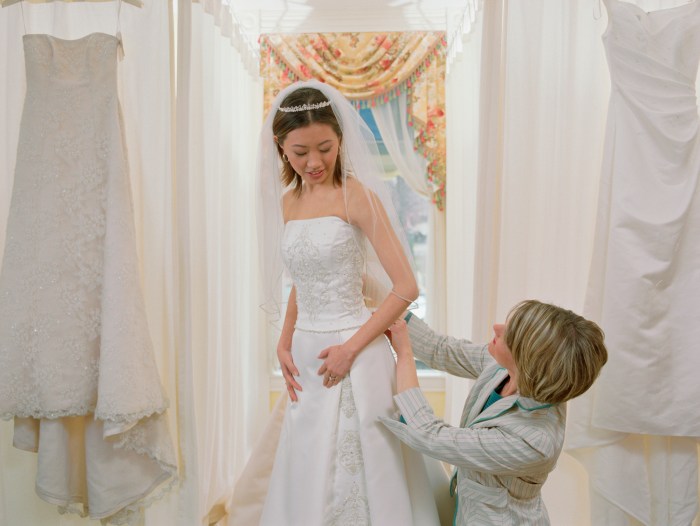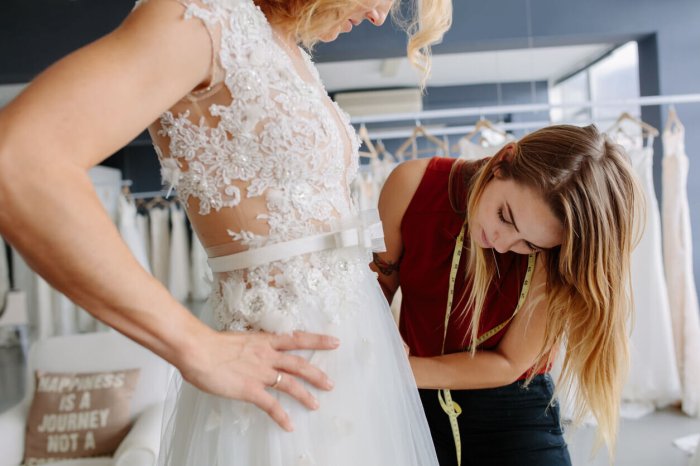
Ideal Timeline for Wedding Dress Alterations
When should you get your wedding dress altered – Planning your wedding dress alterations requires a strategic approach to ensure your gown fits perfectly on your big day. This involves understanding the typical timeline, considering dress style, and anticipating potential delays. A well-structured schedule minimizes stress and maximizes the chances of a flawless fit.
Typical Alteration Timeline
The ideal timeline for wedding dress alterations generally begins 6-8 weeks before the wedding date, allowing ample time for fittings and adjustments. However, the exact timeline depends on several factors, including the complexity of the dress, the type of alterations needed, and the availability of your seamstress. Dresses with intricate beading or lace may require more time, while simpler styles might need less.
Here’s a sample schedule:
| Stage | Task | Timeframe | Potential Delays |
|---|---|---|---|
| Initial Consultation | Discuss alterations, measurements, and create a plan. | 1-2 weeks before first fitting | Seamstress unavailability |
| First Fitting | Initial measurements, basic alterations discussed. | 8-10 weeks before wedding | Dress not ready, fitting issues |
| Second Fitting | Check progress, address major adjustments. | 6-8 weeks before wedding | Significant alterations needed |
| Third Fitting (if needed) | Fine-tune alterations, bustle fitting. | 4-6 weeks before wedding | Unexpected fitting problems |
| Final Fitting | Final checks, ensure perfect fit. | 2-4 weeks before wedding | Minor adjustments needed |
Timeline Comparison for Different Dress Styles
The complexity of the dress style significantly influences the alteration timeline. A-line dresses, generally simpler in design, often require less alteration time compared to ball gowns or mermaid styles, which might need more extensive adjustments to achieve the perfect fit.
For example, a simple A-line dress might only require hemming and minor adjustments to the bodice, taking around 4-6 weeks. In contrast, a ball gown with intricate beading and a long train could take 8-12 weeks due to the added complexity of the alterations.
Factors Influencing Alteration Timing

Source: wedding-spot.com
Several factors beyond the dress style can influence the overall alteration timeline. Understanding these factors allows for better planning and realistic expectations.
Impact of Wedding Date and Dress Complexity
The closer your wedding date, the less time you have for alterations. Booking your seamstress early is crucial, especially during peak wedding seasons. Complex designs, such as heavily beaded or embroidered gowns, require more time-consuming adjustments, potentially extending the overall timeline. Intricate lace details or unique embellishments can also add significant time to the alteration process.
Potential Delays and Contingency Planning
Unforeseen issues can arise, including seamstress unavailability, unexpected fitting issues requiring additional alterations, or delays in receiving the dress from the designer. Having a contingency plan in place, such as scheduling extra fitting appointments or selecting a backup seamstress, can help mitigate these potential problems. Expediting alterations might involve additional costs, so factor this into your budget.
Examples of Expedited or Postponed Alterations, When should you get your wedding dress altered

Source: platdash.com
Situations may arise where alterations need to be expedited or postponed. For instance, if the dress arrives later than expected, the timeline might need adjustment. Conversely, if unexpected weight fluctuations occur, additional fittings may be necessary, potentially delaying the process. Open communication with your seamstress is key to managing these situations effectively.
First Fitting and Subsequent Appointments: When Should You Get Your Wedding Dress Altered
The fitting process is crucial for achieving the perfect fit. Each fitting serves a specific purpose, building upon the previous one to ensure your dress is ready for your special day.
Importance of the First Fitting
The first fitting is essential for establishing a baseline. Your seamstress will take your measurements, discuss your desired alterations, and provide an initial assessment of the necessary adjustments. This is also a great time to discuss any specific concerns or requests you may have.
Subsequent Fittings and Checklist of Questions
Subsequent fittings build upon the previous ones, refining the fit and addressing any remaining issues. Each fitting allows for adjustments to be made and assessed before moving on to the next stage. Here’s a checklist of questions to ask your seamstress at each fitting:
- Are there any areas that still need adjustment?
- How is the overall fit and drape of the dress?
- What alterations are planned for the next fitting?
- What is the estimated timeline for completion?
- Are there any potential issues I should be aware of?
Common alterations addressed during fittings include hemming, taking in seams, adjusting the bodice, adding or altering straps, and fitting the bustle.
Dealing with Unexpected Alteration Needs
Unexpected alterations can arise during the fitting process. Effective communication and problem-solving are crucial for addressing these issues successfully.
Strategies for Handling Unexpected Issues
Maintain open communication with your seamstress. If unexpected problems occur, discuss potential solutions and adjustments to the timeline. Be prepared to be flexible and adapt your plans as needed. Remember that unforeseen issues are sometimes unavoidable, and a good seamstress will work with you to find solutions.
Common Problems and Solutions
- Problem: Dress is too tight/loose. Solution: Seamstress will adjust seams accordingly.
- Problem: Bodice needs adjustments. Solution: Adjustments to darts, seams, or adding boning.
- Problem: Hemline is uneven. Solution: Re-hemming to ensure even length.
- Problem: Zipper or closure malfunction. Solution: Repair or replacement of zipper/closure.
- Problem: Unexpected damage to the dress. Solution: Seamstress will assess damage and provide repair options.
Visual Aids: Illustrating Alteration Processes
Understanding the alteration processes can help you better communicate with your seamstress and manage expectations.
Hemming a Wedding Dress
Hemming involves carefully shortening the dress length. The seamstress typically uses a blind stitch to create an invisible hem, maintaining the dress’s overall aesthetic. This involves measuring the desired length, marking the hemline, and then using a sewing machine or hand-sewing to create a clean, even hem. Specialized tools like seam rippers and measuring tapes are crucial.
Taking in Seams
Taking in seams involves reducing the garment’s size by adjusting the side seams or other areas. This process involves carefully removing existing seams, pinning the new seamline, and resewing it. This requires precision to maintain the garment’s shape and structure. A good seamstress will use a combination of hand-stitching and machine sewing to create a clean, professional finish.
Adding Straps or Sleeves
Adding straps or sleeves involves attaching new fabric components to the bodice. This requires careful measurement and placement to ensure the straps or sleeves are properly aligned and securely attached. The seamstress will choose appropriate stitching techniques and materials to create a seamless and aesthetically pleasing result. This process might involve pattern making, cutting fabric, and precise stitching.
Adding Bustles
A bustle is a mechanism used to lift and secure the train of a wedding dress. Several types exist, including a French bustle (using fabric loops), a ballroom bustle (using buttons and hooks), and a combination bustle (using both methods). The process involves attaching hooks, loops, or buttons to the inside of the dress and the train, allowing for a secure and adjustable lift of the train for the reception.
FAQ Explained
What if I gain or lose weight before my wedding?
Inform your seamstress immediately. Minor weight fluctuations can often be adjusted during fittings. Significant changes might require rescheduling or additional alterations.
How many fittings should I expect?
Typically, two to three fittings are standard. However, more may be necessary depending on the complexity of the alterations.
What should I bring to my fittings?
Bring your wedding shoes, undergarments (similar to what you’ll wear on your wedding day), and any accessories that will affect the fit of your dress (e.g., a petticoat).
Can I alter my dress myself?
Unless you have significant sewing experience, it’s strongly recommended to leave alterations to a professional seamstress to avoid damaging your dress.
What if my seamstress is unavailable closer to my wedding date?
Begin searching for a seamstress well in advance to avoid this issue. If your seamstress becomes unavailable, start searching for a replacement immediately.